Introduction
Wow, has content marketing changed over the years.
Not long ago, content marketing was simpler (or at least it seems like that now, looking back with rose-tinted glasses). Picture 2015: a startup blog could rank on Google with a few well-placed keywords, some decent backlinks, and a handful of 800-word posts sprinkled with generic how-tos. If you published consistently and hit basic SEO checkboxes, you’d likely see at least some useful traffic roll in.
Fast forward to today, and that playbook doesn’t just feel outdated—it’s practically invisible. Google’s algorithm now favors depth over frequency, expertise over fluff, and authenticity over automation. AI-generated content floods the web, yet much of it reads like a copy of a copy. Meanwhile, SEO has evolved from keyword-stuffing tactics to something far more nuanced, balancing topical authority, E-E-A-T (Experience, Expertise, Authoritativeness, Trust), and the unpredictable influence of Google’s Search Generative Experience (SGE). So, relying strictly on AI-generated content without a solid strategy to back it up won’t net you the results you’re looking for.
The brands that are winning at content aren’t just using AI tools to generate it and calling it a day—they’re using AI tools, sure, but they’re also integrating real expertise into the content and distributing that content thoughtfully.
Whether you’re a SaaS founder, a B2B marketer, or an ecommerce strategist, this is your end-to-end roadmap to content marketing that works now. We’ll cover how to build a future-proof content strategy, leverage AI responsibly, align blog and social efforts, measure ROI, and, most importantly, create content that actually helps your business grow.
Let’s dive into what modern content marketing really takes.
Ready to put this strategy to work?
Let’s chat about building or optimizing your content marketing program. Whether you need help with SEO-driven content, AI-assisted workflows, or full-funnel strategy, the Roketto team is here to help.

Why Content Marketing Matters
Content marketing is the process of conducting marketing activities through the use of various content types. Content marketing is also about building trust, educating potential buyers, and creating meaningful engagement that drives results across the entire customer journey.
From capturing attention at the top of the funnel to nurturing prospects in the middle and driving conversions at the bottom, great content creates momentum that turns interest into action.
But the real magic of content marketing lies in its ability to fuel a sustainable growth engine. Instead of chasing quick wins or relying solely on paid traffic, content marketing builds long-term trust, educates your audience, and continuously brings in qualified traffic that’s ready to convert. In a digital world where buyers crave authenticity and value, content becomes the driving force behind visibility, decision-making, and ongoing business growth.
Content’s Role in Buyer Journeys
Modern buyers don’t want to be sold to; they want to be informed. Whether you’re selling software, supplements, or services, content plays a crucial role at every stage of the funnel:
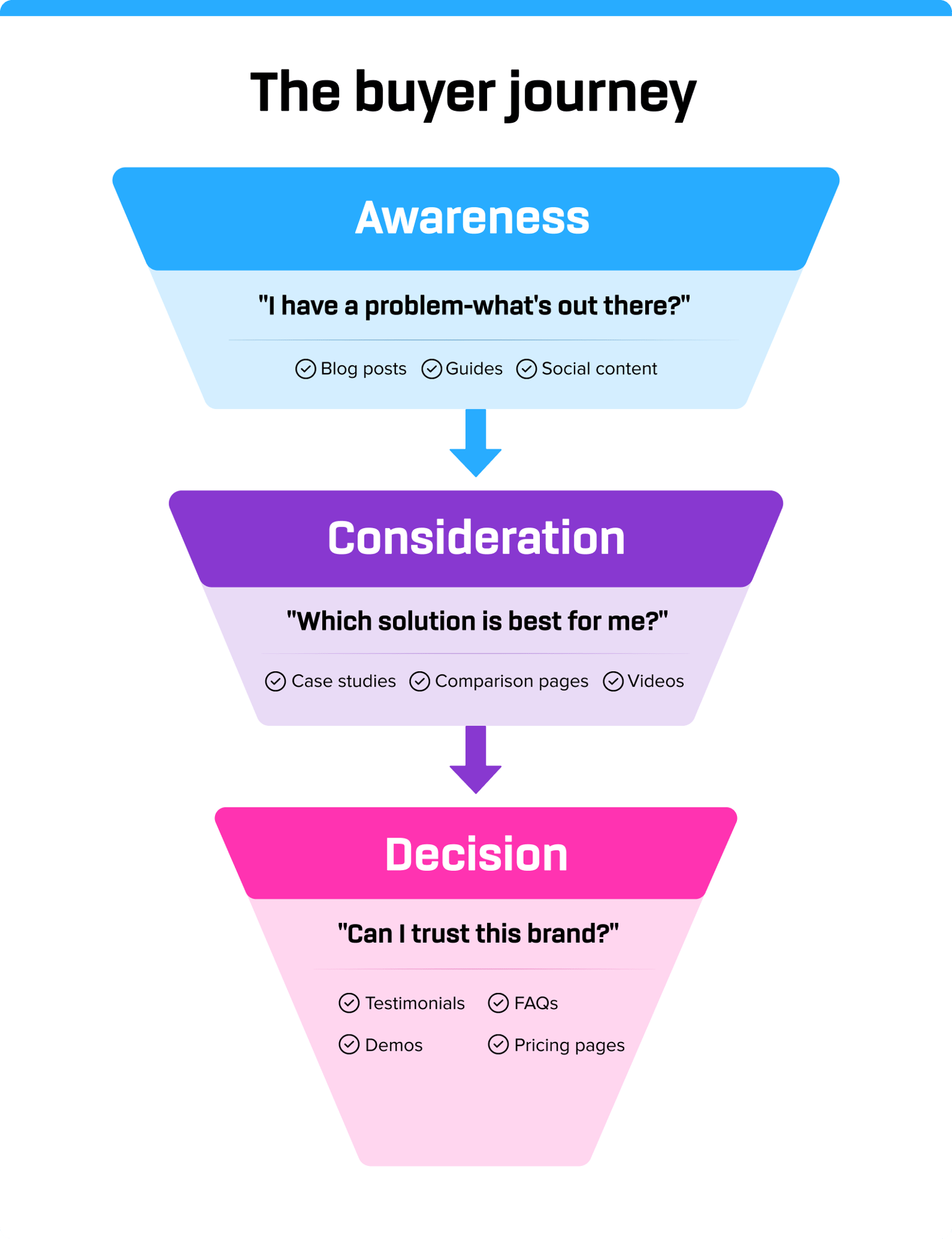
Buyers often complete at least 70% of their decision-making before ever talking to sales, and content is what gets them there. If you’re not showing up with the right content when buyers are actively researching, you’re out of the conversation before it starts.
How Content Marketing Supports Search and AI Discoverability
- Content fuels visibility across both classic SEO and modern AI search
- Search engines and AI tools reward content that is clear, structured, and credible
- Content marketers need to optimize not just for keywords, but for conversation, context, and consistency
Content marketing and search have always been inseparable, but the rules of the game have changed. It's no longer enough to just "rank on Google". Content now needs to work across a dual environment:
- Traditional search engines (Google, Bing)
- AI-powered discovery engines (Google’s SGE, ChatGPT, Claude, Perplexity, and others)
Let’s break down how content marketing helps you win visibility across both.
1 Traditional SEO: Authority Still Reigns—But Context Matters
Search engine algorithms have evolved dramatically, especially with Google's focus on E-E-A-T. That means Google is prioritizing:
- Real-world expertise behind content
- In-depth, structured explanations over thin keyword-stuffed fluff
- Topical authority, not just isolated keyword wins
A strong content marketing strategy helps you:
- Cover entire topic clusters (not just single posts) to signal authority
- Use internal linking and pillar pages to show depth
- Optimize with structured data, summaries, and schema to support search engines
Google's algorithm increasingly values how well your content answers user questions, not just whether it contains the right keywords.
2 Search Is Shifting to Generative AI Platforms
Here’s where things get even more interesting: content isn't just evaluated by search bots anymore—it's being interpreted, repackaged, and summarized by AI assistants like Alexa, Siri, Google Assistant, and more.
Search is becoming more conversational, more contextual, and less reliant on blue-link SERPs. Tools like:

- Google’s Search Generative Experience (SGE) shows AI-generated summaries before organic results
- ChatGPT with browsing, Claude, and Perplexity are delivering sourced answers in natural language
- Voice assistants (like Siri and Google Assistant) are reading content snippets aloud based on search context
If your content isn’t:
- Structured cleanly with headings, lists, summaries, and schema
- Topically comprehensive (e.g., covering entire buyer questions, not just fragments)
- Cited and authoritative
…it may never show up in these AI answers at all.
3 AI Readability Is the New Snippet Optimization
Featured snippets used to be the crown jewel of SEO. Now, they’re just the starting point. AI-driven content summaries favor pages that:
- Begin with clear definitions or overviews (great for paragraph-style snippets)
- Use question-based headers (H2/H3) that mirror search queries
- Include answer blocks immediately following those headers
- Keep answer summaries between 50–60 words (ideal for both snippet and voice search)
Example: Let’s say you want to rank for "What is B2B content marketing?" Place that in an H2, and follow it with a 2–3 sentence definition that’s accurate, original, and well-structured. This is something that content writers have been doing for years, but it’s worth mentioning again since AI platforms favour this structure as well.
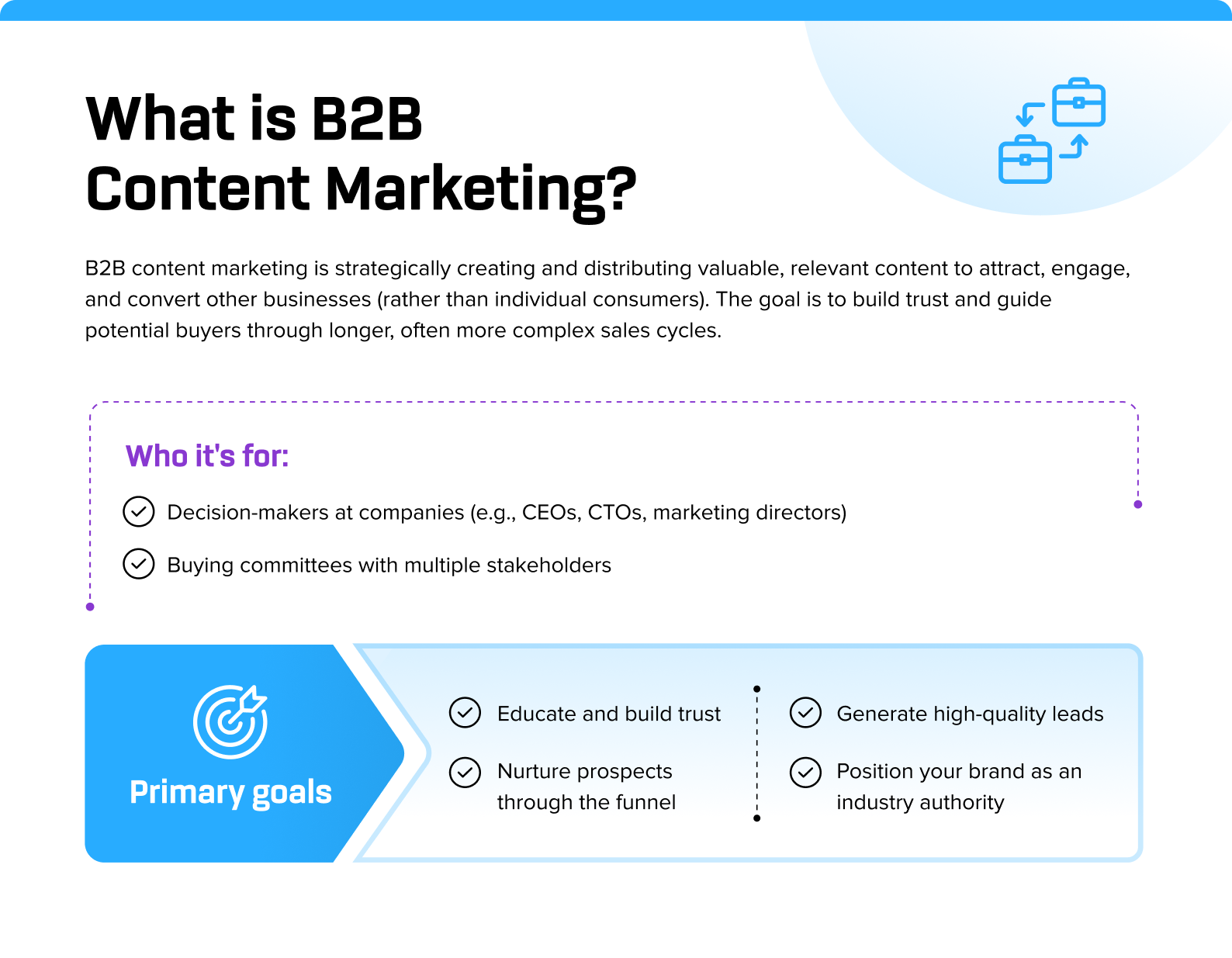
4 Multi-Format Content Gets More Reach
AI tools increasingly value content that can be interpreted in multiple formats, including text, visuals, and audio. Content marketers can future-proof discoverability by:
- Embedding explainer videos, infographics, and transcripts
- Structuring content to be repurposed into carousels, podcasts, or answer boxes
- Creating FAQ sections that AI tools can lift directly
This format diversification increases your chances of being the answer, regardless of where or how the question is asked.
5 Topical Authority > Random Publishing
Publishing a one-off blog post about a high-volume keyword doesn’t cut it anymore. AI tools and Google alike are rewarding brands that cover topics comprehensively.
This means:
- Creating pillar pages supported by interlinked subtopics
- Targeting long-tail keywords and variations to blanket an entire concept
- Demonstrating depth and coherence, not just scattered expertise
When we build out pillar and cluster strategies for SaaS and ecommerce clients, we often see a “rising tide” effect—traffic and rankings improve not just for target posts, but across the entire site.
Inbound vs Outbound Content Marketing
Not all content strategies are created equal. While both inbound and outbound content marketing aim to capture attention and drive business growth, they operate on very different philosophies. Understanding the distinction is essential to building the right strategy for your audience, goals, and resources.
Comparison Table: Inbound vs Outbound Content Marketing
| Feature/Aspect | Inbound Content Marketing | Outbound Content Marketing |
|---|---|---|
| Primary Goal | Attract and nurture leads through valuable, relevant content | Capture attention quickly to generate leads or sales |
| Approach | Pull-based (people seek you out) | Push-based (you go to the people) |
| Common Formats | Blogs, SEO pages, podcasts, webinars, whitepapers, videos | Cold emails, direct mail, paid ads, promotional videos |
| Distribution Channels | Search engines, email lists, social media (organic), owned media | Paid media, bought lists, sponsored placements, cold outreach |
| Tone and Tactics | Educational, helpful, informative | Promotional, persuasive, often time-sensitive |
| User Intent | High intent; users are actively searching for solutions | Low-to-mid intent; users are interrupted or passively targeted |
| Cost Over Time | Lower long-term cost; compounding ROI | Higher ongoing cost; results stop when spend stops |
| Measurement | Traffic, engagement, conversion rate, lead quality | Reach, impressions, clicks, cost per lead |
| Strengths | Builds trust, nurtures relationships, great for complex sales | Faster results, scalable reach, good for time-sensitive offers |
| Best For | B2B, SaaS, ecommerce with longer sales cycles or trust-driven buys | Promotions, events, direct product launches |
Content Marketing, SEO, and AI: What’s Changing?
The content marketing landscape has seen more transformation in the last two years than in the previous decade, and that’s largely thanks to the rise of generative AI. Tools like ChatGPT, Claude, Jasper, and others have made content creation faster, more accessible, and scalable at an unprecedented level.
Let’s break down how this has reshaped the game—and what marketers need to watch out for.
How Tools Like ChatGPT, Jasper, and Claude Have Reshaped Content Production
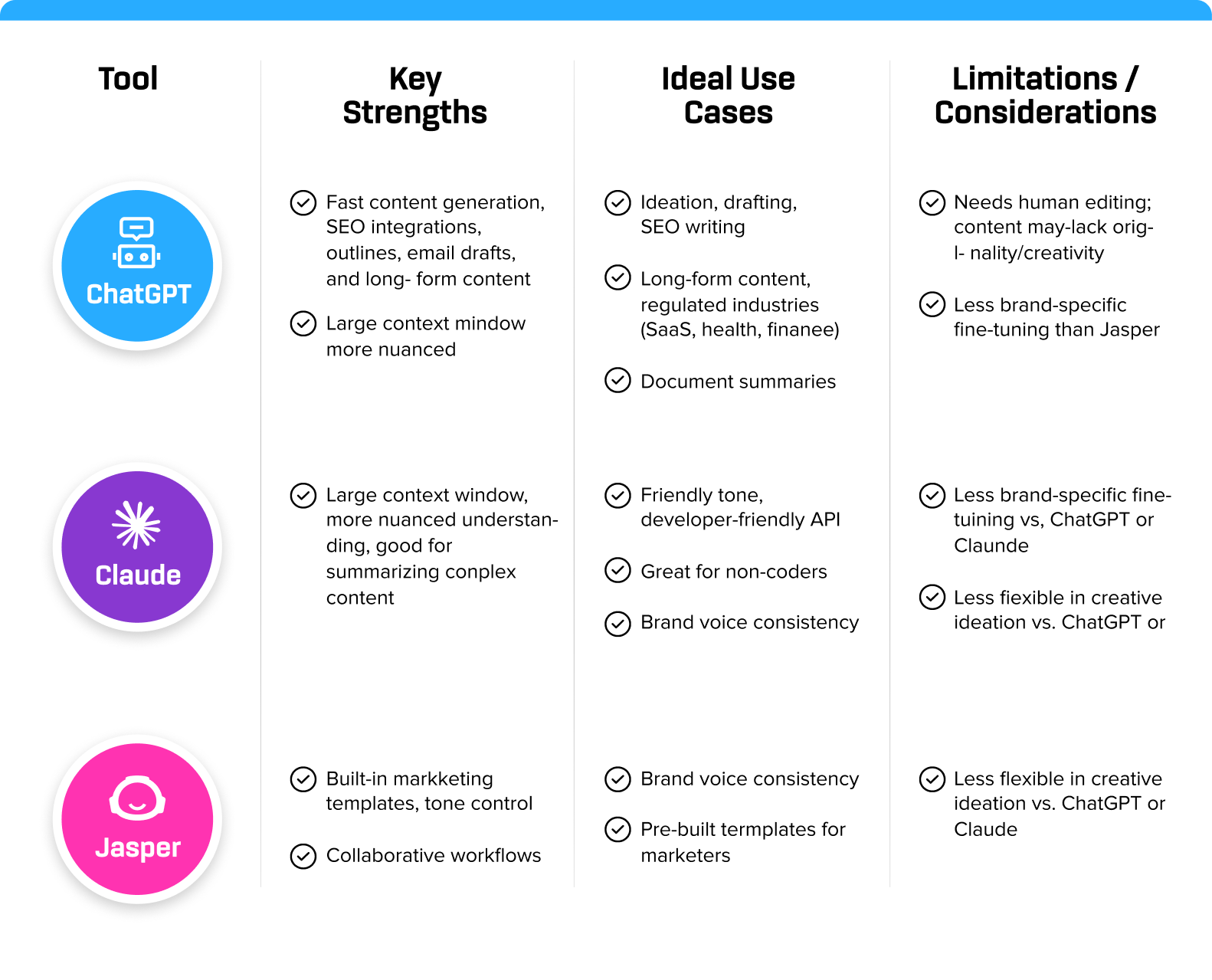
OpenAI’s ChatGPT, launched in late 2022, is now integrated into everything from SEO tools to content platforms. Its ability to rapidly generate outlines, meta descriptions, email drafts, and even long-form content has made it a go-to assistant for marketers.
Stephen Wolfram’s breakdown on AI writing tools, even though it was published back in 2023, is still often referenced by digital marketers and content/copywriters alike due to the piece’s concise explanation of how ChatGPT functions: it works by calculating the most statistically probable next word based on massive datasets.
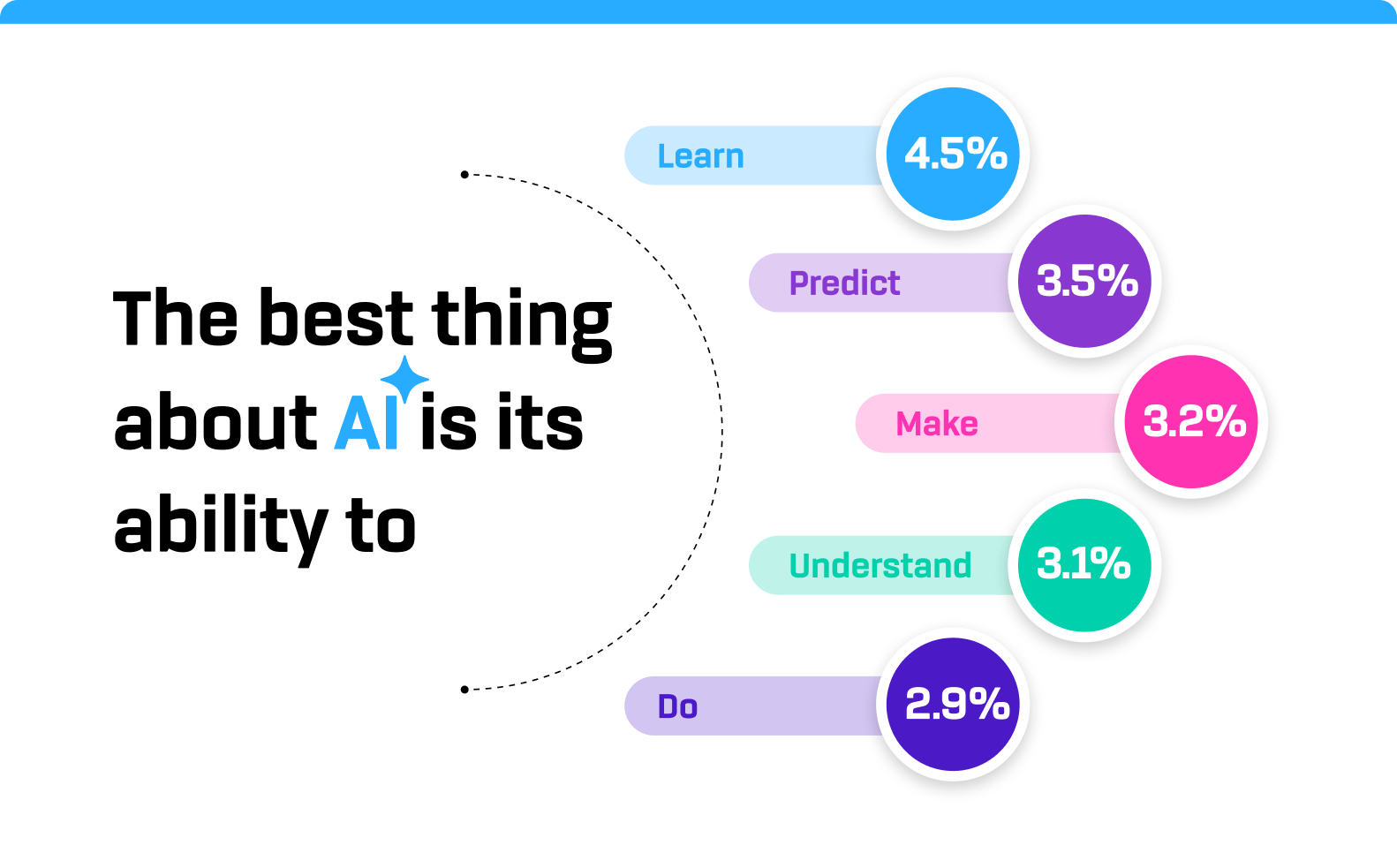
What this looks like in real-world usage is that when you’re writing a piece of content, let’s say an article or essay, it will take a look at a bunch of different words and phrases based on what you’ve written so far (or what its written so far) and then choose the next word that’s the most popular. The important thing to remember is that the tool isn’t trying to be creative; it’s disseminating writing down to mathematical equations of probabilities.
That’s why, in most cases, you’ll want an actual human to review and edit AI-generated content to ensure that it still meets your expectations and content standards. In other words, AI-generated content is great for saving time through ideation and drafts, but you’ll still need strategy, structure, and human editing to produce content that ranks and converts.
Claude: More Context, Less Constraint
However, that doesn’t mean that AI content marketing tools aren’t getting better and better everyday, and that they should be dismissed. The reality is that they’re being used more and more, and marketers should adapt to the constant flux or risk being left behind.
Anthropic’s Claude AI (especially Claude 2 and beyond) has made waves by offering larger context windows and a more “reasoned” tone. It’s great for long-form content and interpreting nuance—something that’s critical for high-trust industries like SaaS, health, or finance. Claude shows promise in summarizing large documents, reducing your research time, and generating a summary in a friendly and readable voice to make difficult or complex topics easier to understand. With its growing API and developer toolkit, Claude is increasingly helping users build AI-powered content workflows without having to write code.
Jasper: The OG Content Marketing Assistant
Before ChatGPT exploded in popularity, Jasper had already made a name for itself with pre-built templates for marketers, providing everything from product descriptions to landing page copy. The main draw for Jasper is its ability to help teams stay consistent with brand voice thanks to tone controls and collaborative content workflows, a task that was once done through a living style guide that was often updated manually by a lead writer. For this reason, it’s still widely used by agencies and internal content teams alike to assist with rapid content execution.
Ready to put this strategy to work?
Let’s chat about building or optimizing your content marketing program. Whether you need help with SEO-driven content, AI-assisted workflows, or full-funnel strategy, the Roketto team is here to help.

Pros and Cons of AI-Generated Content
AI tools like ChatGPT, Jasper, and Claude have completely reshaped how content is produced, but faster doesn’t always mean better. While these tools are excellent at accelerating content creation and ideation, they can’t replace human insight, originality, or strategic direction.
Below is a quick snapshot of where AI shines and where the human touch is still needed to create content that performs.
Table: AI-Generated Content Pros and Cons
| Pros | Cons |
|---|---|
| Generates article outlines in seconds | Can lack depth without subject matter expertise (SME) |
| Speeds up time-to-publish for high-volume workflows | Tone may be inconsistent with brand voice |
| Easily repurposes long-form content into snippets or social posts | Risks violating Google’s E-E-A-T standards if not human-reviewed |
| Offers endless headline, hook, and CTA ideas | May miss search intent or funnel stage alignment |
| Useful for first drafts, briefs, FAQs, and brainstorming | Produces generic or derivative content without strategic guidance |
The Pros: Speed, Scale, and Ideation Support
These tools can:
- Generate article outlines in seconds
- Repurpose long-form content into snippets or social posts
- Offer endless brainstorming ideas for headlines, hooks, and CTAs
- Speed up time-to-publish, especially for high-volume content programs
We often use AI tools to accelerate content workflows, especially for first drafts, content briefs, and repurposing. But AI never replaces our strategic oversight or final human touch.
The Cons: Risk of Generic, Surface-Level Content
While AI speeds things up, it also creates risk:
- Lack of depth: Without SME input, content can feel vague or derivative
- Tone inconsistency: AI may miss the mark on brand voice
- E-E-A-T vulnerabilities: Google’s algorithm favors content backed by real expertise, not machine summaries
- Search intent mismatch: AI may optimize for keywords, but miss buyer context or funnel stage relevance
Ultimately, AI content can help you scale, but it won’t help you stand out unless guided by a real strategy. That’s why we still incorporate keyword research and cluster strategies and get guidance from our clients (the subject matter experts on their company and industry) to create strategic and valuable content.
SEO Is No Longer Just Keywords—It’s Context + Authority
If you’re still thinking of SEO as a keyword checklist, it’s time for a major mindset shift, especially with AI-generated content. Modern SEO has evolved into a multidimensional strategy that rewards depth, relevance, and trust, not just optimization tricks. And as AI-generated content floods the web, the bar for quality has never been higher.
Google’s E-E-A-T: The New SEO Currency
At the heart of this evolution is Google’s E-E-A-T framework: Experience, Expertise, Authoritativeness, and Trustworthiness. We touched on this briefly earlier in this article, but it’s how Google evaluates whether your content deserves to rank—and that includes in their AI Overview and on Google Assistant and Gemini in addition to the SERP itself.
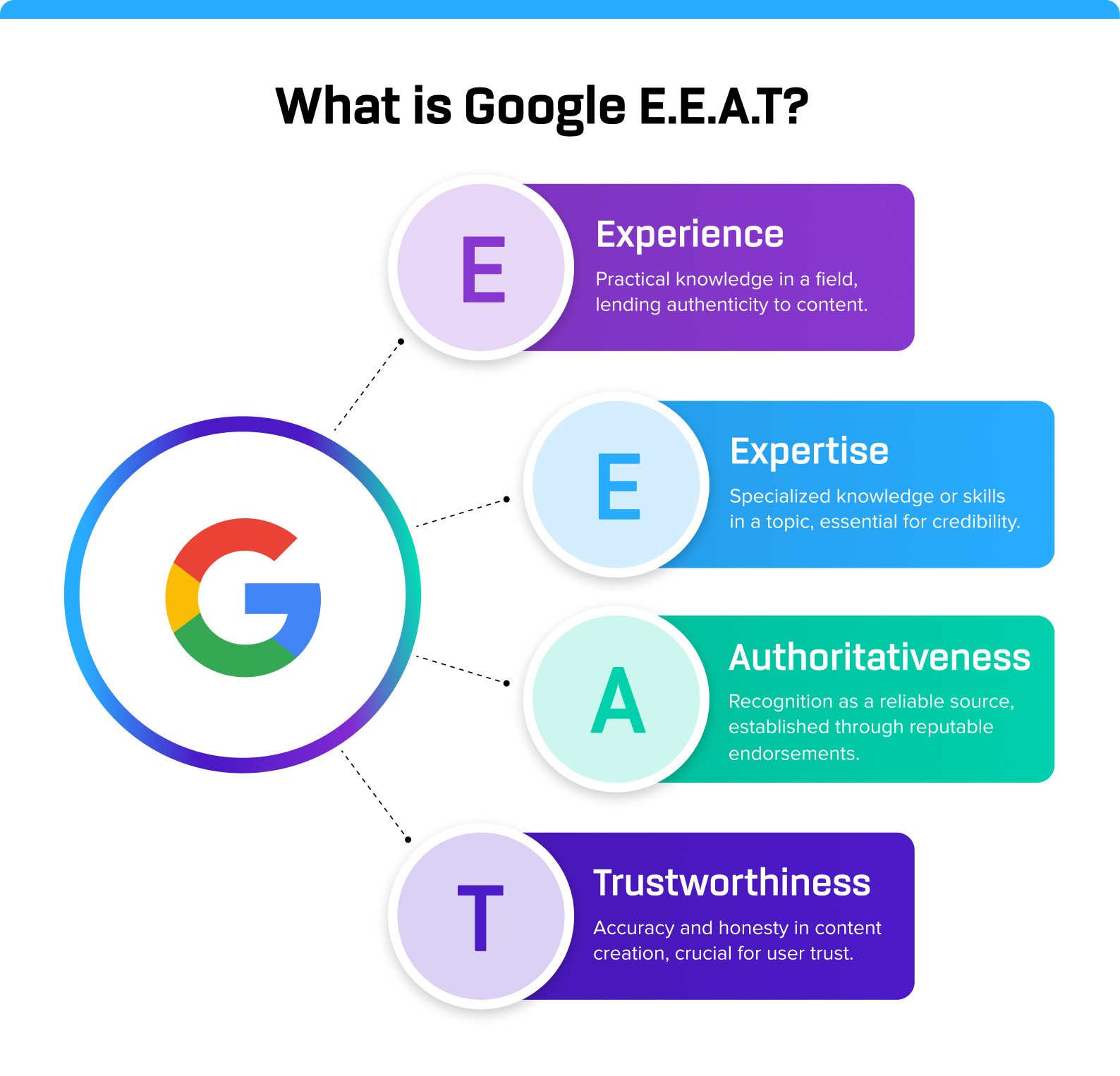
If your blog post, product page, or guide doesn’t demonstrate these qualities, it’s unlikely to surface in today’s AI-assisted search results.
What E-E-A-T looks like in practice:
- Experience: Firsthand knowledge of the subject
- Expertise: Demonstrated skill or depth in the field
- Authoritativeness: Recognized by others as a credible source
- Trustworthiness: Transparent, accurate, and well-sourced content
Here’s some low-hanging fruit that you can take advantage of: tie your content to real authors with credentials, include expert quotes where you can, and always cite reputable sources. On the technical side, use schema markup to signal trustworthiness and to help crawlers understand each page on your website better.
Why Originality and Usefulness Now Trump Keyword Density
For a short time in the early 2000s, keyword stuffing was an actual content strategy that worked. Content marketers that have been in the industry for a long time know the signs well—just take a look at any product description on a website like Amazon. At one point, the whole internet basically looked like that.
Of course, today’s search engines and AI-discovery platforms are much more sophisticated. It’s been a long time since shoehorning random keywords in content has worked. But that doesn’t mean that keywords don’t mean anything, quite the opposite, in fact. Keyword research and cluster strategies are still very important for informing content topics and ideation, but they have to be supported by good content.
Google’s Helpful Content Update and increasing prioritization of human-first content still apply, and perhaps mean more than ever before in a world of AI.
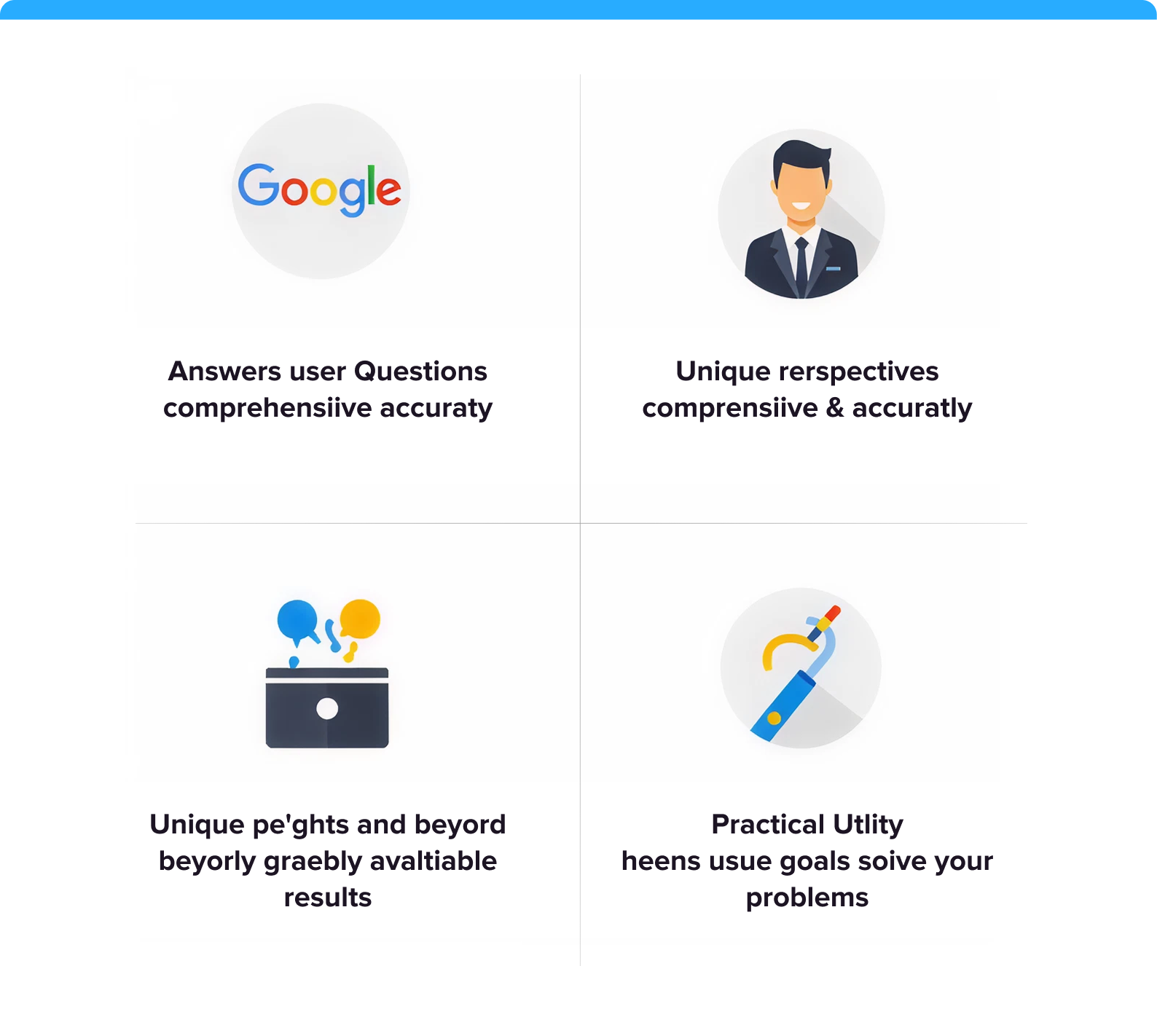
Google rewards content that does three things exceptionally well:
- Answers real user questions clearly and completely
- Demonstrates unique insight or perspective
- Provides utility beyond what’s already available in the SERP
Here’s what that means in practice:
- Thin rewrites won’t rank. Copy-pasting and paraphrasing top-ranking posts adds nothing new to the conversation.
- Surface summaries aren’t enough. AI-generated content that merely repackages what's already online lacks the depth, nuance, and expertise Google is looking for.
- Real-world POVs matter. Case studies, frameworks, personal experience, internal data, and thought leadership are what elevate your content into the top tier.
Originality isn't just creative flair—it’s strategic differentiation. It shows algorithms (and humans) why your content deserves to exist.
In the age of mass-produced AI content, your unique voice, perspective, and expertise are your best assets. This is where SMEs (subject matter experts) play a critical role, ensuring that content doesn’t just rank, but resonates.
AI-Generated Content Still Needs to Serve Human Search Intent
AI tools are phenomenal at generating words, but not meaning. They don’t know your customers. They can’t read the room. And they certainly don’t understand why a prospect is Googling something in the first place.
That’s where search intent comes in.

Search intent is the underlying goal of a user’s query—are they looking to learn, compare, buy, troubleshoot, or just explore? Misaligning your content with that intent is one of the fastest ways to tank its SEO value, regardless of how well it’s written or optimized.
Here’s the challenge:
- AI can suggest keywords, cluster topics, or even draft outlines.
- But it can’t reliably prioritize which questions matter most to your audience at which stage of the funnel.
- And it doesn’t grasp emotional nuance—like urgency, skepticism, or confusion—that your content should be addressing.
Great content speaks to humans with specific problems, not just algorithms scanning for keywords. So while AI can absolutely support your content production, strategic alignment must come from a human who understands your audience, your funnel, and your differentiation. If your content doesn’t map to real user intent, it doesn’t matter how fast or often you publish. It won’t perform.
What Makes a Strong Content Strategy Now?
Search algorithms favour depth, AI tools flood the web with content, and buyer journeys have grown more complex. This means that a strong content strategy must do more than just check the right SEO boxes; it must connect meaningfully with humans, thoughtfully leverage AI, and align with your business goals at every stage of the funnel.
Here’s what that looks like today:
1 Search Intent Mapping Must Be Sharper
Search intent is the foundation of strategic content creation. Understanding why someone is searching (and where they are in their buying journey) determines not only what to write, but also how to frame it, what format to use, and what CTAs to include.
AI tools like Semrush, Clearscope, or ChatGPT can:
- Suggest keyword clusters
- Identify search volumes and variations
- Surface “People Also Ask” insights
But human strategists are still essential to:
- Prioritize content by funnel stage (awareness, consideration, decision)
- Filter noise from nuance (not all high-volume keywords are worth pursuing)
- Translate search behavior into strategic storytelling
Example: AI may suggest a keyword like “best CRM for small business.” But it takes a marketer to know that this searcher likely needs a decision-stage product comparison, not a beginner’s guide.
2 Human Voice & POV Are More Valuable Than Ever
As AI-generated content floods the web, what separates top-performing content is a human perspective, meaning a voice grounded in experience, personality, and real-world insight.
Here’s what sets human-centered content apart:
- Original frameworks or step-by-step processes developed through firsthand experience
- Customer stories or lessons learned that demonstrate credibility and authenticity
- Clear author identity, which supports Google’s E-E-A-T (Experience, Expertise, Authoritativeness, Trustworthiness) guidelines
Search engines (and more importantly, people) can feel when content is written by someone who gets it.
3 Content Workflows Are Getting Hybrid
Modern content teams are no longer doing everything manually, but they’re not relying on AI blindly either. The future lies in hybrid workflows that combine the best of both worlds:
- AI for speed: Drafting outlines, generating meta descriptions, writing variations of headlines
- Humans for quality and conversion: Shaping narrative arcs, refining brand voice, aligning to customer psychology
- Strategy as the glue: Keeping every piece aligned with broader business objectives
Think of AI as your production assistant, not your content director.
The real ROI comes when content is:
- Created with a clear intent and purpose
- Reviewed through a strategic lens
- Optimized for both human readers and search engines
Ready to put this strategy to work?
Let’s chat about building or optimizing your content marketing program. Whether you need help with SEO-driven content, AI-assisted workflows, or full-funnel strategy, the Roketto team is here to help.

Building a Winning Content Strategy in the Age of AI
The AI era has made content easier to produce—but harder to perfect.
Winning strategies blend structure, speed, and smarts, combining AI tools with human creativity, domain expertise, and ongoing optimization.
1 Brief—Start With a Clear Content Mission
Before you create anything, define why it matters.
- Clarify business goals: Are you driving awareness, increasing engagement, or pushing for conversions?
- Match content themes to customer pain points: Every article should solve a real problem, not just fill space.
- Create a usable content brief: Include target keywords, audience segment, funnel stage, and AI prompt instructions to align both human writers and AI co-creators. A clear, strategic brief minimizes rework, especially when scaling content with AI.
At Roketto, we create content briefs for each of our blog posts that include the core keyword (topic) that the post will be about, a list of keyword variations, an outline for the article (as well as a rationale that explains the idea and direction of the article) and the title and meta description. This ensures that our writers understand the strategy behind each blog post and helps guide them in their writing.
2 Intent—Map Topics to Search & Buyer Intent
Search is no longer just keyword-driven—it’s intent-driven. That means understanding the why behind every search query.
- Classify by intent: Informational (how-to), transactional (buy now), or navigational (brand/product)
- Leverage AI tools like AlsoAsked, Semrush, or ChatGPT to cluster and model topics
- Map to funnel stages: Align each topic with awareness, consideration, or decision content for strategic sequencing
In each of our content briefs, we also explain the intent behind the post—whether it’s a listicle, guide, how-to article, or something else. This is explained in the rationale.
3 Source—Ground Content in Real Expertise
AI can generate language, but it can’t replicate lived experience. That’s where subject matter experts (SMEs) come in.
- Identify internal or external SMEs who have firsthand insight
- Gather quotes, stories, or workflows that only humans can offer
- Maintain E-E-A-T signals by attributing content to real people and linking to trustworthy sources

Google increasingly rewards expert-driven content with stronger visibility, especially in YMYL (Your Money, Your Life) sectors.
4 Constraints—Set Guardrails for Consistency
Without clear parameters, AI content can easily go off the rails. Guardrails ensure brand consistency and editorial quality.
- Define tone, voice, and format rules in your content guidelines
- Use structured templates for blog posts, FAQs, and landing pages
- Set token/word constraints in AI prompts to avoid bloat or repetition
Constraints don’t limit creativity; they instead channel it into consistent, on-brand execution.
5 Uniqueness—Differentiate With POV + Brand Personality
With so much sameness online, originality is your edge.
- Add proprietary frameworks, personal anecdotes, or case studies
- Weave in analogies or metaphors that simplify complexity
- Tailor content for niche audiences (e.g., SaaS vs ecommerce) to increase relevance
AI can generate facts (but make sure you double-check them). Once you have those facts, adding your perspective helps generate trust.
6 Integration—Weave Content Into Multi-Channel Campaigns
A strong content strategy doesn’t live in isolation. Instead, it’s integrated across your marketing ecosystem.
- Align blog topics with social media, email, and paid campaigns
- Use your content hub to anchor topic clusters and cross-link assets
- Leverage AI for fast repurposing: convert articles into email sequences, carousels, or video scripts
7 Test—Validate Performance and Iterate Fast
A content strategy is never “set and forget.” The winners constantly test, learn, and evolve.
- Track KPIs like rankings, traffic, dwell time, conversions, and assisted revenue
- Use AI tools like ChatGPT + GA4 summaries, SurferSEO, or Looker Studio to analyze faster
- Update and improve underperforming content based on real user behaviour
Blog Content Strategy vs Social Media Content Strategy
Your content strategy doesn’t live in a vacuum, and it shouldn’t live in silos either. Blog content and social media serve different purposes, use different formats, and reach your audience at different stages of the buyer journey. But when used together strategically, they become a powerful, complementary force.
Comparison Table: Blog vs Social Content Strategy
| Element | Blog Content Strategy | Social Media Content Strategy |
|---|---|---|
| Primary Purpose | Drive organic search traffic, educate, convert | Build brand awareness, spark engagement, amplify content |
| Audience Intent | High-intent: researching, comparing, learning | Low-to-mid intent: browsing, discovering, reacting |
| Format | Long-form articles (800–3000+ words), SEO-optimized | Short-form posts, stories, reels, carousels, memes |
| Lifespan | Evergreen and long-lasting (months to years) | Short-term and fast-moving (days or hours) |
| Tone | Informative, authoritative, structured | Conversational, punchy, emotionally engaging |
| Platform | Owned (website, blog) | Rented (LinkedIn, Instagram, Twitter, TikTok) |
| Measurement Metrics | Organic traffic, time on page, conversions, lead gen | Engagement rate, reach, shares, clicks, brand mentions |
| Best For | SEO, demand gen, content compounding, thought leadership | Community building, campaign amplification, social proof |
Strategic Goals for Each Channel
Blog Content Strategy:
A blog content strategy is all about creating in-depth, evergreen content that helps your audience solve real problems, while also helping your brand rank in search engines.

It's your long-form SEO engine, brand library, and digital trust builder all rolled into one. Blog content is typically mapped to buyer journey stages and optimized for intent-driven keywords. This strategy works best when you build topic clusters around core themes, interlink relevant articles, and structure posts for both user readability and SEO performance. Over time, this compounds into topical authority, higher organic traffic, and stronger lead generation. A blog also supports gated content (like eBooks and webinars), improves paid ad landing pages, and gives sales teams assets to share with leads. For SaaS and B2B companies, in particular, it's a crucial tool for establishing thought leadership and educating buyers over longer sales cycles.
Social Media Content Strategy:
Social media content strategy focuses on distribution, engagement, and reach, not deep exploration. It’s designed to stop the scroll, spark interaction, and build brand familiarity through fast, emotionally resonant content. Think short-form videos, image carousels, polls, memes, punchy quotes, and trending conversations. Unlike blog content, social media is fleeting—algorithms reward recency and relevance, not depth or longevity. But it’s powerful for shaping brand perception, humanizing your company, and drawing attention to your long-form content assets. A strong social strategy helps you grow your audience, amplify your brand voice, and test content angles in real time. And since platform trends shift quickly, this strategy requires more flexibility and frequency than blogging, but when done well, it can dramatically boost reach and community trust.
How to Make Blog and Social Work Together
Instead of treating blog and social media as separate silos, the smartest marketers treat them as a feedback loop. Your blog provides the long-form, authoritative content that informs and educates. Social media, in turn, becomes the distribution engine that brings that content to life across channels. For example, a 2,000-word blog post can fuel a month’s worth of social snippets, including quote graphics, LinkedIn carousels, tweet threads, and even short videos. Likewise, insights from social engagement (like frequently asked questions, poll responses, or high-performing comments) can inspire new blog content based on what your audience clearly wants to know. Embedding social CTAs in blog posts (such as “Share this on LinkedIn” or tweetable quotes) encourages amplification. This interconnected strategy keeps your content flywheel spinning, delivering compounding value across formats and platforms.
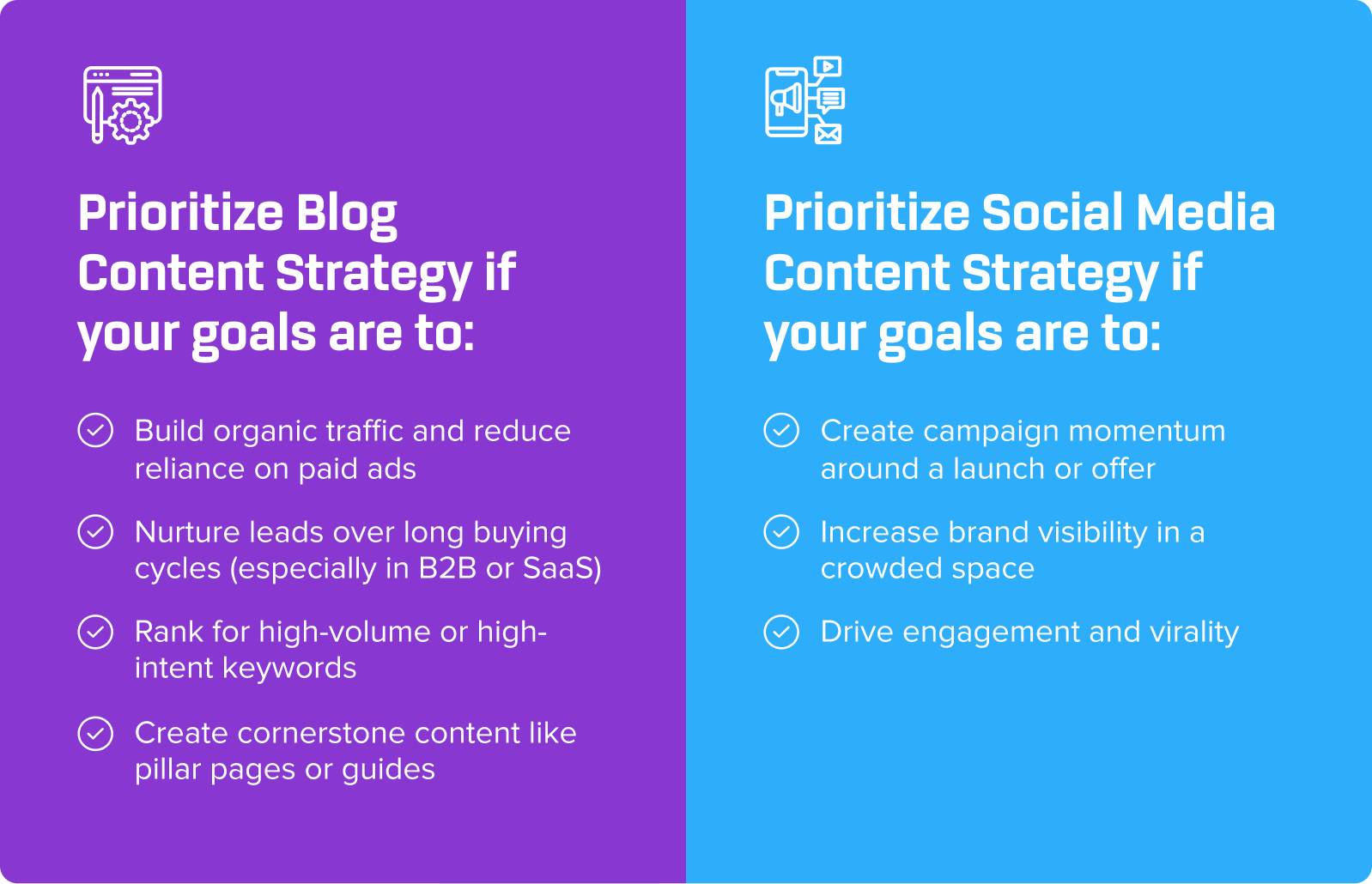
Types of Content Marketing
There’s no one-size-fits-all when it comes to content formats. Different audiences consume content in different ways, and each type of content serves a unique purpose depending on where the buyer is in their journey.
A smart content strategy doesn’t rely on just one format, it blends multiple types of content to reach users across the funnel, from discovery to decision. Below is a breakdown of the most common (and effective) content types, along with how and when to use them.
Comparison Table: Content Format vs Goal vs Funnel Stage
| Content Format | Primary Goal | Best Funnel Stage |
|---|---|---|
| Blog Posts | Drive SEO traffic, educate, nurture leads | Awareness/Consideration |
| Video Content | Increase engagement, explain complex topics | Awareness/Consideration |
| Webinars | Generate leads, demonstrate expertise | Consideration/Decision |
| Infographics | Visual storytelling, simplify data-heavy content | Awareness |
| Case Studies | Prove value through real results | Decision |
| Whitepapers / eBooks | Capture leads, offer deep insights | Consideration/Decision |
| Podcasts | Build trust and brand affinity | Awareness/Consideration |
| Interactive Content | Increase engagement, collect data | Awareness/Consideration |
Blog Posts
Blog posts are the backbone of most inbound strategies. They're ideal for targeting high-intent keywords, answering questions your audience is already Googling, and demonstrating topical authority. They drive long-term SEO traffic and are a great entry point into your content funnel. From how-to guides to industry roundups, blogs should be optimized for both users and search engines, with a clear CTA to move readers down the funnel.
Video Content

Webinars
Webinars combine education and lead capture, allowing you to deliver deep value while collecting sign-ups and engaging live with your audience. They’re great for middle- to bottom-of-funnel marketing, especially for SaaS and B2B brands that need to build trust before conversion. Bonus: you can repurpose webinar recordings into blog posts, short clips, and gated assets.
Infographics
Infographics help you tell a story visually, making statistics, comparisons, and processes more digestible. They’re perfect for top-of-funnel discovery, particularly on social platforms and Pinterest. Infographics are highly shareable, which also makes them great for link-building and amplifying your reach.
Case Studies
Case studies are your best tool for showing proof. They provide concrete, real-world examples of how your product or service delivers value, builds credibility, and overcomes objections. A well-written case study includes the problem, solution, and results—and can often be the tipping point for leads in the decision stage.
Whitepapers/eBooks
These long-form assets are perfect for B2B and SaaS audiences looking for depth. Unlike blog posts, whitepapers and eBooks often focus on original research, industry trends, or actionable frameworks. They're usually gated, making them great lead generation tools that position your brand as a thought leader.
Podcasts
Podcasts allow your brand to “speak” directly to your audience, building familiarity and trust over time. They're an excellent medium for thought leadership, expert interviews, and long-form storytelling. Best of all, podcasts are portable—your audience can engage with your content during commutes, workouts, or downtime.
Interactive Content
Quizzes, calculators, assessments, and tools make content feel personal and engaging. These formats also provide zero-party data, which is valuable information users willingly give in exchange for personalized insights. They're ideal for increasing time on site, capturing leads, and guiding users toward relevant solutions.
Ready to put this strategy to work?
Let’s chat about building or optimizing your content marketing program. Whether you need help with SEO-driven content, AI-assisted workflows, or full-funnel strategy, the Roketto team is here to help.

Content Marketing Strategy by Industry
While the fundamentals of content marketing, like delivering value and building trust, are universal, the execution varies dramatically by industry. Different audiences have different buying behaviors, content consumption habits, and decision timelines. A well-tuned content strategy must reflect those nuances.
Let’s explore how content marketing needs to be adapted across three key verticals: B2B, SaaS, and e-commerce.
B2B Content Marketing
Business-to-business (B2B) content marketing requires an audience-first approach rooted in education, authority, and long-term trust. These buyers are often part of a committee, have longer sales cycles, and need to justify decisions with logic, ROI, and risk mitigation.
Key traits of B2B content strategy:
- Long-form educational content: Whitepapers, pillar blog posts, and webinars that dive deep into complex topics
- Lead nurturing: Email sequences, case studies, and comparison guides tailored to each stage of the buyer journey
- Multi-persona targeting: Different content for end-users, influencers, and executive decision-makers
- Distribution through thought leadership: LinkedIn, industry forums, and publications are core channels
B2B Content Marketing Examples:
- A consulting firm publishes a “State of the Industry” report to attract C-level leads
- A cybersecurity company uses interactive assessments to qualify prospects
- A logistics tech startup uses demo-focused blog posts and ROI calculators to support sales enablement
SaaS Content Marketing
SaaS content marketing shares many characteristics with B2B, but with an added layer of product education and activation. Since SaaS products often solve very specific problems, the content strategy must help buyers understand how the product works and why it matters to them.
Key elements of SaaS content strategy:
- Educational blog content to drive organic search and teach users about the problem and solution
- Product tutorials and demo videos to visually explain key features and benefits
- Gated content like templates, eBooks, and checklists to capture leads and deliver upfront value
- Customer success stories that showcase real-world use cases and results
For SaaS clients like Ringy, we scale monthly blogs, create deep comparison pages, and use long-form educational content to reduce paid ad dependency and increase demo sign-ups.
Ecommerce Content Marketing
Ecommerce content is less about abstract education and more about inspiring purchases and building brand affinity. A marketing strategy for ecommerce must blend SEO, social proof, and visual content that resonates quickly with shoppers.
Key ecommerce content tactics:
- Product-led SEO: Optimized product pages, buyer guides, and review roundups
- User-Generated Content (UGC): Photos, reviews, and videos that increase trust and reduce friction
- Tutorials and how-to guides: Helping users visualize how products are used in real life
- Lifestyle storytelling: Blog content that speaks to aspirational goals or identities
Ecommerce Content Marketing Examples:
- A pet supplement brand (like our client Integricare) publishes an article on “Best Joint Support Products for Senior Dogs,” ranking for high-intent keywords
- A DTC skincare company shares customer UGC on Instagram and repurposes it into review pages
- A furniture retailer uses room inspiration blogs to improve internal linking and product discovery
Tools That Power Great Content Marketing
Great content is just as much about execution as it is about creativity. The right tools streamline every step of the process, from idea to optimization to ROI. Whether you're running an in-house team or managing content across multiple clients or departments, these tools help scale quality, consistency, and impact.
Tools That Power Great Content Marketing
The right systems, workflows, and tech power high-performing content marketing. From discovery to distribution, the tools you use can dramatically affect your efficiency, visibility, and ROI. This section breaks down the most essential tools across every stage of the content lifecycle.
Summary Table: Content Marketing Tools & What They Do
| Category | Top Tools | What They Do |
|---|---|---|
| Keyword Research | Ahrefs, Semrush | Identifies keywords, search volume, competition, and gaps in your content strategy |
| Content Planning | Notion, Trello, ClickUp, Reddit Answers | Organizes ideas, manages editorial workflows, and gathers real audience insights |
| Writing & Optimization | Surfer SEO, Grammarly | Optimizes content for on-page SEO and refines grammar, clarity, and tone |
| Design | Canva, Figma | Creates graphics, infographics, and visual assets to enhance content appeal |
| Distribution | HubSpot, Mailchimp (or other ESPs) | Publishes and promotes content via email, CRM, and marketing automation |
| Analytics | Google Analytics, Looker Studio | Tracks performance metrics, user behavior, and visualizes ROI and traffic trends |
Keyword Research Tools

As we know, keyword research is the foundation of SEO-driven content marketing. The right tools help you uncover what your audience is searching for and identify gaps in your current coverage.
- Ahrefs is ideal for deep keyword research, backlink analysis, and SERP monitoring. Its "Content Gap" and "Top Pages" tools help identify opportunities your competitors are capitalizing on so you can take advantage of them too.
- Semrush offers a similar toolkit with added functionality for PPC planning, SEO writing assistance, and content topic suggestions. It’s especially strong in keyword intent modeling and SERP features tracking.
The best strategies go beyond search volume. Use these tools to understand intent, seasonality, and ranking difficulty, then prioritize content that aligns with both SEO opportunities and business goals.
Content Planning Tools

Planning tools keep your content strategy organized, repeatable, and collaborative. They help teams align on what’s being created, when, and why.
- Notion acts as a central hub for editorial calendars, content briefs, guidelines, and SOPs. Its flexible structure makes it great for solo marketers or large teams needing customizable workflows.
- Trello provides a visual board view ideal for simple pipelines—think "To Do," "In Progress," "Review," and "Published."
- ClickUp adds powerful features like task dependencies, time tracking, workload management, and Gantt charts. It’s best for larger content ops or cross-functional teams.
- Reddit Answers is a free and creative way to gather content ideas straight from user-generated conversations. It’s like audience research meets keyword inspiration.
Combining internal workflows (ClickUp/Notion) with external listening (Reddit, forums, review sites) gives you both operational clarity and audience relevance.
Writing & Optimization Tools

Great content needs to be both well-written and well-optimized. These tools ensure your content is polished, purposeful, and positioned to rank.
- Surfer SEO analyzes the top-performing content in SERPs and gives real-time suggestions for word count, keyword placement, structure, and semantic relevance. It bridges the gap between human creativity and algorithmic needs.
- Grammarly goes beyond basic proofreading. It improves tone, engagement, and clarity, especially helpful when collaborating across teams or editing AI-generated drafts.
Start with SEO intent in mind ( you can use Surfer SEO to help), then refine for tone and audience experience using Grammarly or even tools like Hemingway or Writer.
Design Tools

Content works the best when it’s supported by visual, emotional, and interactive elements. These tools help you craft high-impact visuals that increase engagement and brand memorability.
- Canva is a user-friendly design tool that enables marketers (even without formal design training) to create polished graphics, social visuals, infographics, and blog banners.
- Figma is better suited for design teams or advanced users building wireframes, landing pages, or brand systems. However, it’s user-friendly enough that content writers and other stakeholders can participate in the process via its real-time collaboration features, which makes it excellent for design-review workflows.
Use Canva for speed and versatility, and Figma when you need scalable, cross-team collaboration or UI/UX elements.
Distribution Tools

Even the best content won’t perform if no one sees it. Distribution platforms help automate publishing, nurture leads, and deliver personalized experiences at scale.
- HubSpot is an all-in-one content management, CRM, and automation platform. It’s perfect for teams that want to connect blogs, email marketing, lead capture, and reporting in one ecosystem.
- Mailchimp (or similar ESPs like ConvertKit or ActiveCampaign) focus on email marketing. They offer segmentation, drip campaigns, and analytics, making them great for promoting new content and nurturing leads.
Align your distribution tools with your funnel strategy, including automating follow-ups for gated content, building nurture sequences around blog categories, and using behavioural triggers to personalize the journey.
Analytics Tools

Measurement is everything. Without the right tracking, you’re flying blind. These tools show you what’s working, what’s not, and where to optimize.
- Google Analytics gives detailed insights into how users arrive on your site, what they do, and where they drop off. Use it to track key metrics like bounce rate, conversion paths, and traffic sources.
- Looker Studio transforms raw data from GA, HubSpot, Search Console, and more into custom dashboards that communicate value clearly to stakeholders. These dashboards are perfect for agency reporting, internal reviews, or executive summaries.
Use Looker Studio to combine SEO, engagement, and conversion data into a single, digestible view—so you can make fast, confident decisions.
Measuring Content Marketing ROI
With content marketing, we often have to prove value in different ways because it doesn’t provide the same quick results as other forms of digital marketing, like paid advertising. While blog posts, videos, and guides can drive incredible long-term growth, measuring their actual return on investment (ROI) can be complex. Unlike paid ads, content doesn’t always offer instant feedback, but that doesn’t mean it can’t be measured. You just need the right framework.
Here’s how to track the KPIs that matter in content marketing, use attribution models to connect content to outcomes, and overcome common ROI problems in the real world.
KPIs That Matter
The best content metrics vary depending on your goals, but if you're measuring content performance across the funnel, these are the must-haves:
1. Traffic
- What to track: Organic sessions, referral traffic, direct visits
- Why it matters: A consistent rise in traffic shows growing discoverability and content visibility in search and other channels.
- How to dig deeper: Use Google Analytics or Search Console to identify what topics are driving traffic, and whether that traffic is aligned with your ideal customer.
2. Time on Page/Engagement
- What to track: Average time on page, scroll depth, bounce rate
- Why it matters: Indicates how compelling and useful your content is. Higher time spent often correlates with better content quality and stronger user intent.
- Bonus metric: Track “engaged sessions” in GA4 for more nuance than bounce rate alone.
3. Conversions (Macro + Micro)
- What to track:
- Macro: Demo requests, purchases, form fills
- Micro: Newsletter signups, PDF downloads, video views
- Why it matters: Content is doing its job if it moves users closer to a business outcome.
- Tip: Track conversion rates per blog post or content type to see what actually drives results. Use goals and events in GA4 or HubSpot to map blog-to-conversion pathways.
Attribution Models for Content
Content is a multi-touch contributor that often assists conversions rather than closing them directly. That's why choosing the right attribution model is essential to understand true ROI.
| Model | What It Does |
|---|---|
| First-Touch | Credits the first interaction (great for measuring content discovery) |
| Last-Touch | Credits the final action before conversion (often underrepresents content) |
| Linear | Evenly splits credit across all touchpoints |
| Time Decay | Weighs more recent interactions more heavily |
| Position-Based (U-Shaped) | Credits first and last touch the most, and distributes the rest evenly |
Use multi-touch attribution for a more accurate view of how content contributes throughout the funnel, especially in long sales cycles like SaaS or B2B.
Tools to Track Performance
Tracking ROI is much easier with the right toolkit in place.
- Google Analytics: Core traffic and conversion tracking
- Looker Studio: Combine data sources into clear visual reports
- HubSpot: Tracks content-driven lifecycle stages and attribution across contacts
- Search Console: Identifies keyword rankings and CTR trends
- Surfer SEO or ClearScope: Measures content scores, optimizations, and SERP performance
- Hotjar or Microsoft Clarity: Adds heatmaps and session replays for qualitative insight
For SaaS and lead-gen brands, connecting Google Analytics + CRM (like HubSpot or Salesforce) is crucial to trace the path from first visit to customer.
Common Challenges With Proving ROI (And How to Overcome Them)
1. Content Has a Long Tail (But Stakeholders Want Quick Wins)
Content often takes 3–6+ months to rank and generate conversions, especially for new sites or competitive keywords.
Solution: Set realistic time-based benchmarks (e.g., rankings by month 3, traffic by month 6, conversions by month 9). Use leading indicators like engagement and traffic growth early on.
2. Content Contributes, But Doesn’t Convert Directly
Many blog posts assist conversions rather than close them. Last-touch models underreport this value.
Solution: Use multi-touch or position-based attribution models. Show assisted conversions and include content influence reports in your monthly analytics.
3. Content Value Is Hard to Quantify Across Channels
You know your blog drives traffic to your product page, but can’t prove the value in cold, hard numbers.
Solution: Take a page from SparkToro’s content ROI approach. Rand Fishkin recommends identifying behavioral signals (e.g., branded search increases, referral spikes) and using correlation, not causation, to support your case.
Not everything needs a perfect attribution trail. You're on the right track if your traffic, branded search, and lead quality are rising alongside your content efforts.
When to Hire a Content Marketing Agency
Creating great content consistently requires creativity, strategy, systems, expertise, and time. As your business scales or your marketing needs become more complex, it’s natural to reach a point where your in-house team (or solo marketer) can’t do it all. That’s where a content marketing agency can become a game-changing partner.
So, how do you know when it’s time to bring one in—and what should you look for when trying to pick the right fit?
Signs You Need Outside Help
Not sure if it’s time to outsource your content? Here are some clear signals:
- You’re inconsistent with publishing: If your blog hasn’t been updated in months or your content calendar is perpetually “under construction,” you likely lack the bandwidth to execute consistently.
- Your internal team is maxed out: Your marketers are juggling strategy, social, email, and demand gen, and content keeps falling to the bottom of the list.
- You’re seeing flat SEO growth: Your site traffic is stagnant, and you're not ranking for high-value keywords despite publishing.
- You’re not getting leads from your content: You're creating content, but it’s not converting. There’s a gap between traffic and action.
- You want to scale, but not hire full-time: Hiring an agency lets you increase output and expertise without the overhead of building a full internal team.
- You lack strategic direction: You’re publishing, but you’re not sure if it’s the right content, targeting the right audience, or aligned with your business goals.
Benefits of Working With a Specialized Agency
Not all agencies are created equal, but the right one can deliver value far beyond just content execution. Here’s what a great content marketing agency brings to the table:
- Strategic clarity: Agencies bring outside perspective and proven frameworks to align your content with SEO, brand, and conversion goals.
- Scalable execution: You can instantly increase production volume (blogs, guides, case studies, etc.) without hiring or training.
- Top-tier tools & processes: Agencies often use premium tools (e.g., Surfer SEO, Ahrefs, HubSpot) and have tested content workflows that keep things efficient.
- Diverse talent: Gain access to experienced strategists, writers, designers, SEO experts, and editors—often at a lower cost than assembling this team internally.
- Results-oriented reporting: Agencies track KPIs, provide clear analytics, and optimize based on performance, not guesswork.
What to Look for in a Content Marketing Agency
Hiring a content marketing agency is just as much about fit as specialization and capabilities. Here’s what to consider when evaluating partners:
| What to Look For | Why It Matters |
|---|---|
| Industry experience | Do they understand your space (e.g., SaaS, ecommerce)? Can they speak your audience’s language? |
| Strategic approach | Can they map content to funnel stages, search intent, and business goals? |
| Proven frameworks & processes | Do they have a clear methodology (like Roketto’s HyperContent strategy)? |
| Content samples & case studies | Can they show work that ranks, converts, and drives results? |
| SEO + storytelling skills | Are they balancing data-driven SEO with creative, brand-aligned messaging? |
| Transparent communication | Will you have a clear point of contact, timely updates, and shared KPIs? |
Content Marketing Strategy Templates and Resources
A great content strategy is only as good as your ability to execute it, and that’s where content templates and documented frameworks come in. Whether you’re managing content in-house or working with external partners, these ready-to-use tools help ensure consistency, alignment, and speed.
Below are four essential templates and resources every high-performing content team should have in place.
Content Calendar Template
A content calendar is your single source of truth for what’s being published, when, and by whom. It gives your team visibility, streamlines production workflows, and helps balance content across formats, funnel stages, and channels.
What it includes:
- Publish dates
- Assigned writers and reviewers
- Content format and goal (e.g., SEO, nurture, thought leadership)
- Target keywords and funnel stage
- Promotion channels (email, social, paid)
Content Brief Template
Before writing starts, every piece of content should be anchored in a strategic brief. A well-structured brief aligns writers, editors, SEOs, and designers on exactly what the piece is meant to accomplish.
What it includes:
- Core topic and working title
- Primary and secondary keywords
- Target audience and buyer persona
- Funnel stage and intended CTA
- Suggested outline or structure
- Tone of voice, reference links, and SME input
A great brief saves hours in revisions and ensures the final content meets both audience expectations and business goals. We created ours natively in Google Docs, but you can also use tools like Clearscope or SurferSEO.
Strategy Deck Sample
Your content strategy deck is the blueprint that aligns content marketing with your broader business objectives. It’s also a powerful tool for stakeholder buy-in and reporting.
What it includes:
- Content goals mapped to business KPIs
- Audience personas and journey stages
- Core topics and pillar themes
- Competitive landscape insights
- Distribution and amplification plan
- KPIs and measurement framework
Whether you’re pitching leadership, onboarding a new agency, or auditing your current efforts, a clear strategy deck (usually created in PowerPoint, Google Slides, or Prezi) keeps everyone moving in the same direction.
Style Guide Template
A content style guide ensures that every piece of content, regardless of who writes it, feels consistent and on-brand. This becomes especially important as you scale production or involve multiple contributors. Oftentimes, content style guides are blended into brand style guides, which include visual direction for graphic designers as well as colours, specific messaging, and more.
What it includes:
- Voice, tone, and messaging pillars
- Grammar rules, spelling preferences (US vs. Canadian English)
- Formatting guidelines (headings, bullets, CTAs)
- Examples of "do’s and don’ts" specific to the client and/or industry
- Approved terminology and branding language
- Visual standards for charts, infographics, and image use
A solid style guide doesn’t just make your content look better, it builds trust with your audience through consistency and clarity. We build style guides for our clients through our Client Discovery process, but you can also create your own in Google Docs, an internal wiki for your company, or any other collaborative content editing tool.
Conclusion
Content marketing has always evolved over time, but in the age of AI, SEO disruption, and increasingly savvy buyers, that evolution is accelerating at breakneck speed.
What used to work, including basic blog posts, keyword stuffing, and one-size-fits-all messaging—just isn’t enough anymore. Today’s best-performing content strategies are intent-driven, insight-rich, and strategically structured to reach the right people with the right message at the right moment.
And yes, AI tools have changed the game, but they haven’t replaced it. The marketers who are winning right now aren’t the ones publishing the most content—they’re the ones creating the most relevant, helpful, and authentic content, while using AI to scale and sharpen execution (not replace strategy or voice).
Here’s the big takeaway: If you want your content to stand out and convert, it has to be built for humans first, and optimized for search and AI second. That means clear briefs, deep understanding of buyer intent, thoughtful topic planning, SME input, and distribution strategies that meet your audience wherever they are in their journey.
Whether you’re running content in-house or with agency support, you now have the playbook to build a modern, resilient content engine—one that drives not just traffic, but real business growth.
Ready to put this strategy to work?
Let’s chat about building or optimizing your content marketing program. Whether you need help with SEO-driven content, AI-assisted workflows, or full-funnel strategy, the Roketto team is here to help.






